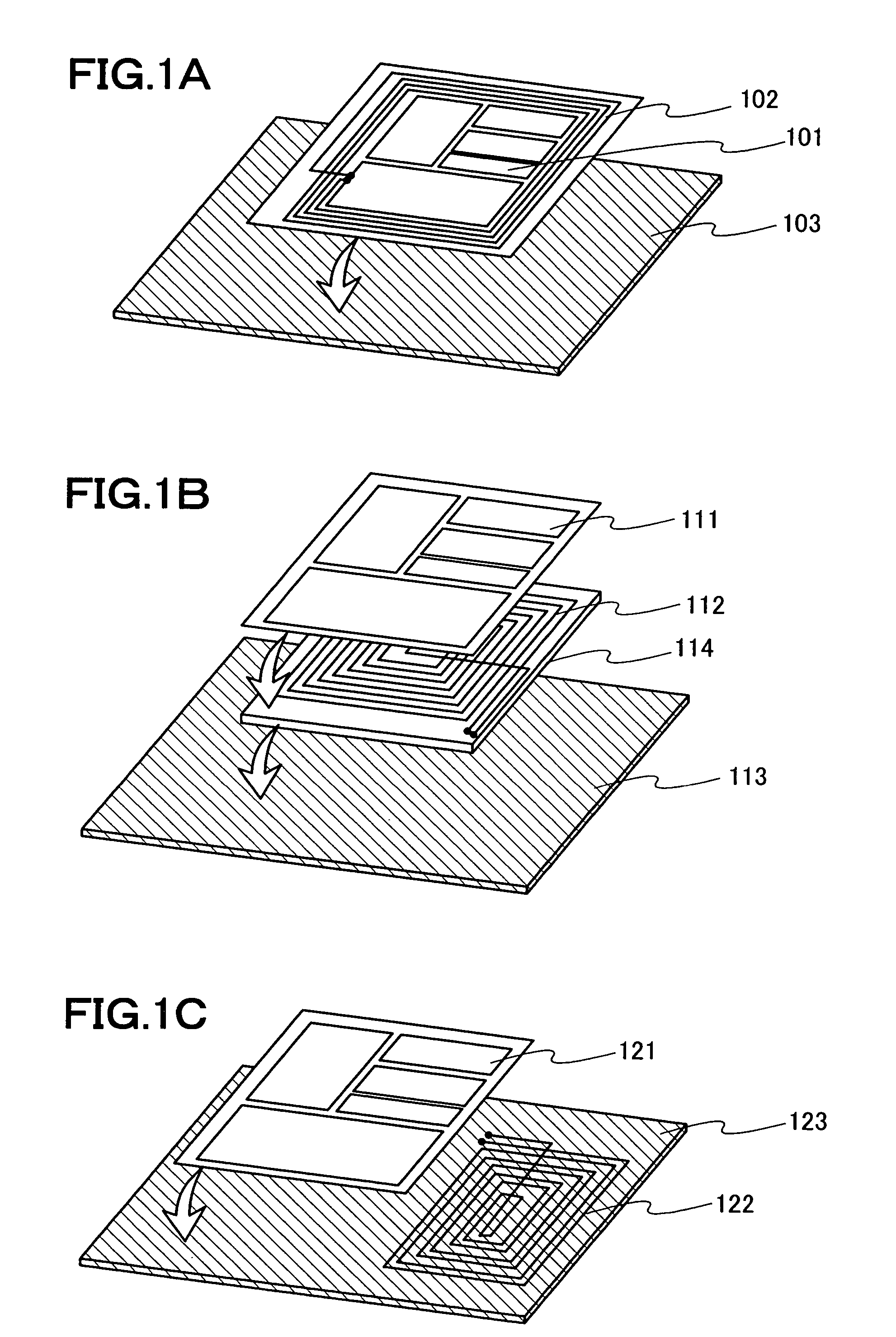Semiconductor device and manufacturing method thereof
a semiconductor and semiconductor technology, applied in the direction of semiconductor/solid-state device details, mechanical actuation of burglar alarms, instruments, etc., can solve the problems of increasing chip size, increasing cost per chip, and difficulty in maintaining circuit scale and antenna gain, so as to prevent signal attenuation due to shielded radio waves, less shielded, and the effect of reducing the diameter of the antenna
- Summary
- Abstract
- Description
- Claims
- Application Information
AI Technical Summary
Benefits of technology
Problems solved by technology
Method used
Image
Examples
embodiment 1
[0120]Described in this embodiment is an example of forming a plurality of wireless tags by using a large substrate.
[0121]FIG. 10A shows a case in which a plurality of antennas 902 used for wireless tags are formed on a large flexible substrate 901 functioning as a support. At the same time, a plurality of thin film integrated circuits 903 are attached onto the flexible substrate 901 in FIG. 10A. When being attached, the thin film integrated circuits 903 are electrically connected to the antennas 902.
[0122]FIG. 10B shows a case in which the plurality of thin film integrated circuits 903 are attached onto the substrate 901. Although the antennas 902 and the thin film integrated circuits 903 are disposed to be adjacent to each other in FIG. 10B, the invention is not limited to this configuration. The antennas 902 and the thin film integrated circuits 903 may be overlapped to have a stacked structure.
[0123]Then, as shown in FIG. 10C, scribing or dicing is performed along a dashed line ...
embodiment 2
[0124]In this embodiment, applications of the wireless tag of the invention are described.
[0125]The wireless tag of the invention can be applied to various fields. For example, the wireless tag of the invention can be attached to a product label to control the flow of product.
[0126]As shown in FIG. 11A, a wireless tag 1102 of the invention is formed on a support with a sticky backside such as a seal 1101 and then attached to a product label 1103. Subsequently, as shown in FIG. 11B, the label 1103 attached with the wireless tag 1102 is put on a product 1104.
[0127]Identification data of the product 1104 can be wirelessly read from the wireless tag 1102 attached to the label 1103 as shown in FIG. 11C. Therefore, the wireless tag 1102 facilitates the control of product in the distribution process.
[0128]For example, in the case of a nonvolatile memory being used as a memory of a thin film integrated circuit in the wireless tag 1102, the distribution process of the product 1104 can be rec...
embodiment 3
[0130]In this embodiment, applications of the wireless tag of the invention are described.
[0131]When a thin film integrated circuit in the wireless tag of the invention includes a memory such as a ROM in which data cannot be rewritten, it is possible to prevent forgery of bills, checks, family registers, resident cards, traveler's checks, passports and the like. Further, when the wireless tag is used for foods whose commercial value depends crucially on a production area, a producer and the like, the forgery of production area, producer and the like can be prevented at low cost.
[0132]FIG. 13A shows an example of a check 1301 including a wireless tag 1302 of the invention. In FIG. 13A, the wireless tag 1302 is put inside the check 1301, though it may be exposed outside the check 1301.
[0133]FIG. 13B shows an example of a passport 1311 including a wireless tag 1312 of the invention. In FIG. 13B, the wireless tag 1312 is put on a cover of the passport 1311, though it may be put on other...
PUM
| Property | Measurement | Unit |
|---|---|---|
| frequencies | aaaaa | aaaaa |
| frequencies | aaaaa | aaaaa |
| diameter | aaaaa | aaaaa |
Abstract
Description
Claims
Application Information
 Login to View More
Login to View More - R&D
- Intellectual Property
- Life Sciences
- Materials
- Tech Scout
- Unparalleled Data Quality
- Higher Quality Content
- 60% Fewer Hallucinations
Browse by: Latest US Patents, China's latest patents, Technical Efficacy Thesaurus, Application Domain, Technology Topic, Popular Technical Reports.
© 2025 PatSnap. All rights reserved.Legal|Privacy policy|Modern Slavery Act Transparency Statement|Sitemap|About US| Contact US: help@patsnap.com



